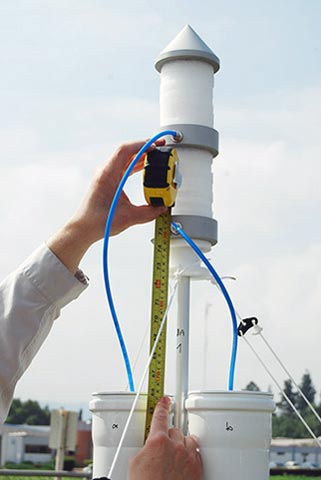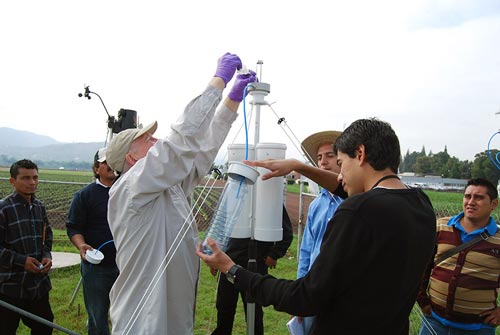By Brenna Goth/CIMMYT

The ten tall pollen traps that recently sprouted in the fields at El Batán could replace growing and harvesting maize as a cheaper, easier, and more comprehensive method of monitoring germplasm for transgenes. The traps are part of a pilot project that leaders from CIMMYT’s Maize Germplasm Bank and Seed Health Laboratory are testing at the three experiment stations in Mexico.
The unintentional presence of transgenes can be a concern for those requesting germplasm from CIMMYT’s bank. CIMMYT does not grow transgenic maize on-site, but transgenic pollen could come in from surrounding areas, said Denise Costich, head of the Maize Germplasm Bank. CIMMYT does not expect to detect GMO pollen in its nurseries, but there are other maize growers near the El Batán station. “The bottom line is that we need to be able to guarantee to our clients that, to the best of our knowledge, the seed we are sending them is GMO free,” Costich said. The current testing process, which has been used since 2008, involves growing border rows of maize and sending the resulting grain to an independent laboratory in Iowa. It requires harvesting and sending 10 or 15 kilograms of maize per station, and each load requires about 10 samples at more than $200 each. Testing occurs every cycle, which is once per year in El Batán and twice per year in Agua Fría and Tlaltizapán.
The new traps—called Pollen Mass Filter samplers (PMF)—collect airborne pollen for four weeks. The pollen is then extracted, filtered, and shipped to the lab in a small tube. It’s a lighter and more compact load than the grain, and, as opposed to harvesting, the pollen traps only require a filter change and one sample per cycle. The PMF system will also be more comprehensive. The CIMMYT gene bank grows maize varieties from all over the world with a wide range of flowering times but the border row method only monitors the flowering period of the specific maize variety used in the border.

A continuous, non-biological pollen monitoring system, on the other hand, can cover diversity in flowering times, Costich said. Thirteen pollen samples have already been sent to Iowa, with all testing negative for the presence of transgenes, said Monica Mezzalama, head of the Seed Health Laboratory and member of the Biosafety Committee. Both methods of monitoring are being used this year. Costich said she researched the traps, which are popular in Europe, after thinking there had to be a more efficient monitoring method than testing kilograms of maize seed. The traps arrived from Germany at the end of May, followed by Frieder Hofmann, the inventor of the pollen sampler and an expert on environmental monitoring, who helped to assemble the traps and trained the team how to use them. During this summer cropping cycle, ten traps have been installed at El Batán, while the Agua Fría and Tlaltizapán stations each have one.
The goal of this pilot year is to determine how well the traps work, how much pollen is collected, and how many traps are needed for a comprehensive monitoring system. Costich said the next step for testing the detection ability of the PMF system is to install the traps in an area where transgenic maize is currently being grown.
 Capacity development
Capacity development 
